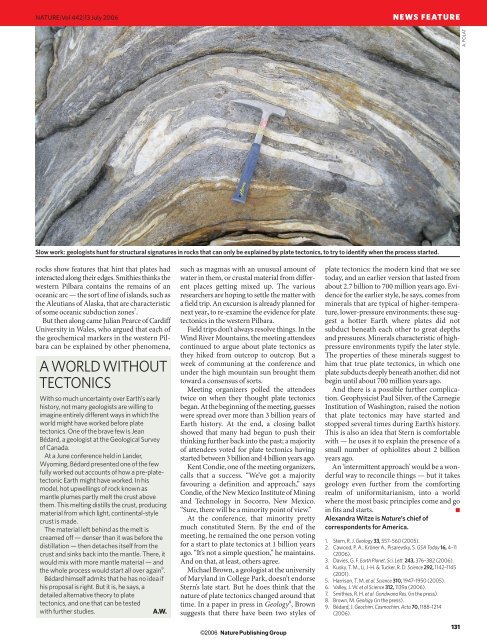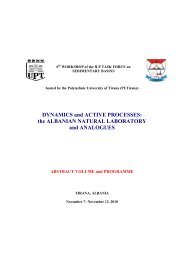JOHANNES GUTENBERG-UNIVERSITÄT MAINZ - International ...
JOHANNES GUTENBERG-UNIVERSITÄT MAINZ - International ...
JOHANNES GUTENBERG-UNIVERSITÄT MAINZ - International ...
You also want an ePaper? Increase the reach of your titles
YUMPU automatically turns print PDFs into web optimized ePapers that Google loves.
NATURE|Vol 442|13 July 2006 NEWS FEATURE<br />
Slow work: geologists hunt for structural signatures in rocks that can only be explained by plate tectonics, to try to identify when the process started.<br />
rocks show features that hint that plates had<br />
interacted along their edges. Smithies thinks the<br />
western Pilbara contains the remains of an<br />
oceanic arc — the sort of line of islands, such as<br />
the Aleutians of Alaska, that are characteristic<br />
of some oceanic subduction zones 7 .<br />
But then along came Julian Pearce of Cardiff<br />
University in Wales, who argued that each of<br />
the geochemical markers in the western Pilbara<br />
can be explained by other phenomena,<br />
A WORLD WITHOUT<br />
TECTONICS<br />
With so much uncertainty over Earth’s early<br />
history, not many geologists are willing to<br />
imagine entirely different ways in which the<br />
world might have worked before plate<br />
tectonics. One of the brave few is Jean<br />
Bédard, a geologist at the Geological Survey<br />
of Canada.<br />
At a June conference held in Lander,<br />
Wyoming, Bédard presented one of the few<br />
fully worked out accounts of how a pre-platetectonic<br />
Earth might have worked. In his<br />
model, hot upwellings of rock known as<br />
mantle plumes partly melt the crust above<br />
them. This melting distills the crust, producing<br />
material from which light, continental-style<br />
crust is made.<br />
The material left behind as the melt is<br />
creamed off — denser than it was before the<br />
distillation — then detaches itself from the<br />
crust and sinks back into the mantle. There, it<br />
would mix with more mantle material — and<br />
the whole process would start all over again 9 .<br />
Bédard himself admits that he has no idea if<br />
his proposal is right. But it is, he says, a<br />
detailed alternative theory to plate<br />
tectonics, and one that can be tested<br />
with further studies. A.W.<br />
such as magmas with an unusual amount of<br />
water in them, or crustal material from different<br />
places getting mixed up. The various<br />
researchers are hoping to settle the matter with<br />
a field trip. An excursion is already planned for<br />
next year, to re-examine the evidence for plate<br />
tectonics in the western Pilbara.<br />
Field trips don’t always resolve things. In the<br />
Wind River Mountains, the meeting attendees<br />
continued to argue about plate tectonics as<br />
they hiked from outcrop to outcrop. But a<br />
week of communing at the conference and<br />
under the high mountain sun brought them<br />
toward a consensus of sorts.<br />
Meeting organizers polled the attendees<br />
twice on when they thought plate tectonics<br />
began. At the beginning of the meeting, guesses<br />
were spread over more than 3 billion years of<br />
Earth history. At the end, a closing ballot<br />
showed that many had begun to push their<br />
thinking further back into the past; a majority<br />
of attendees voted for plate tectonics having<br />
started between 3 billion and 4 billion years ago.<br />
Kent Condie, one of the meeting organizers,<br />
calls that a success. “We’ve got a majority<br />
favouring a definition and approach,” says<br />
Condie, of the New Mexico Institute of Mining<br />
and Technology in Socorro, New Mexico.<br />
“Sure, there will be a minority point of view.”<br />
At the conference, that minority pretty<br />
much constituted Stern. By the end of the<br />
meeting, he remained the one person voting<br />
for a start to plate tectonics at 1 billion years<br />
ago. “It’s not a simple question,” he maintains.<br />
And on that, at least, others agree.<br />
Michael Brown, a geologist at the university<br />
of Maryland in College Park, doesn’t endorse<br />
Stern’s late start. But he does think that the<br />
nature of plate tectonics changed around that<br />
time. In a paper in press in Geology 8 , Brown<br />
suggests that there have been two styles of<br />
©2006<br />
Nature Publishing Group<br />
plate tectonics: the modern kind that we see<br />
today, and an earlier version that lasted from<br />
about 2.7 billion to 700 million years ago. Evidence<br />
for the earlier style, he says, comes from<br />
minerals that are typical of higher-temperature,<br />
lower-pressure environments; these suggest<br />
a hotter Earth where plates did not<br />
subduct beneath each other to great depths<br />
and pressures. Minerals characteristic of highpressure<br />
environments typify the later style.<br />
The properties of these minerals suggest to<br />
him that true plate tectonics, in which one<br />
plate subducts deeply beneath another, did not<br />
begin until about 700 million years ago.<br />
And there is a possible further complication.<br />
Geophysicist Paul Silver, of the Carnegie<br />
Institution of Washington, raised the notion<br />
that plate tectonics may have started and<br />
stopped several times during Earth’s history.<br />
This is also an idea that Stern is comfortable<br />
with — he uses it to explain the presence of a<br />
small number of ophiolites about 2 billion<br />
years ago.<br />
An ‘intermittent approach’ would be a wonderful<br />
way to reconcile things — but it takes<br />
geology even further from the comforting<br />
realm of uniformitarianism, into a world<br />
where the most basic principles come and go<br />
in fits and starts. ■<br />
Alexandra Witze is Nature’s chief of<br />
correspondents for America.<br />
1. Stern, R. J. Geology 33, 557–560 (2005).<br />
2. Cawood, P. A., Kröner A., Pisarevsky, S. GSA Today 16, 4–11<br />
(2006).<br />
3. Davies, G. F. Earth Planet. Sci. Lett. 243, 376–382 (2006).<br />
4. Kusky, T. M., Li, J-H. & Tucker, R. D. Science 292, 1142–1145<br />
(2001).<br />
5. Harrison, T. M. et al. Science 310, 1947–1950 (2005).<br />
6. Valley, J. W. et al Science 312, 1139a (2006).<br />
7. Smithies, R. H. et al. Gondwana Res. (in the press).<br />
8. Brown, M. Geology (in the press).<br />
9. Bédard, J. Geochim. Cosmochim. Acta 70, 1188–1214<br />
(2006).<br />
131<br />
A. POLAT




